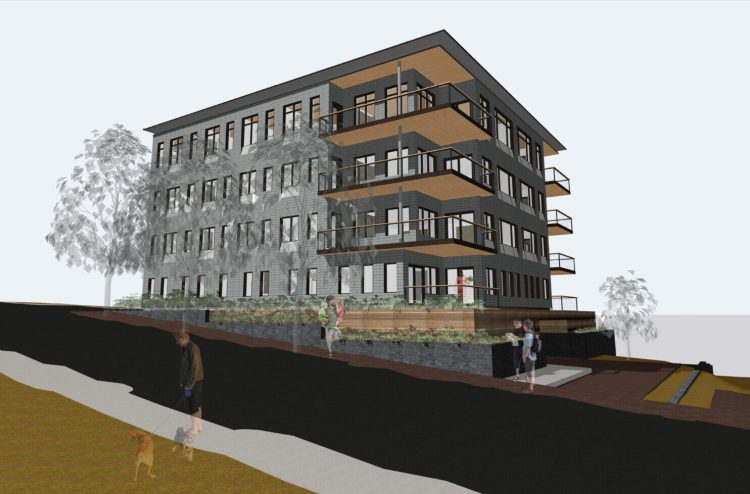Two housing developments proposed for Munjoy Hill require demolishing homes, raising concerns anew about the pace of development in the neighborhood and the replacement of rental apartments with high-end condos.
Developer Tim Wells has submitted an application to the Portland Planning Department to demolish three homes at 33 and 37 Montreal St. to make way for a nine-unit condo building. A couple of blocks away, a group of friends plans to tear down a home and put up a new building with six apartments.
The two projects are the first to propose demolishing existing homes in a historic conservation area, called a conservation overlay district, enacted last year in response to a wave of demolitions and new building in the neighborhood.
Under the rules, for one year after a new development is proposed it has to get demolition and design approval from the city’s historic preservation board if city planners deem that a building due for demolition might be saved.
Even though both projects meet conservation requirements, some community members think even tougher standards are needed for new development. City officials are debating whether to create a historic district that would result in more layers of review for construction in parts of the neighborhood.
Wayne Valzania, president of the Munjoy Hill Neighborhood Organization, worries developers are exploiting loopholes in the existing conservation rules. Even with additional review, proposed buildings usually clash with the neighborhood’s character, he said.
“Just because a building should come down, it doesn’t mean that architecturally it is no-holds-barred for something that is totally profit-driven instead of something that fits in and enhances the neighborhood,” Valzania said. The historic district should encompass the entire neighborhood, he said, instead of the proposed boundaries limiting it to a section south of Congress Street and along North Street.
“We feel that what is proposed is a good start, we are really adamant about something being in place,” he said.
PRESERVATION VERSUS DEMOLITION

Wells went before the historic preservation board last year when he applied to build a 14-unit condo building on the Montreal Street property. Even though the project was approved, he’d like the city to modify the procedure, and questions if the preservation board is the best citizen committee to oversee the process.
“They thought they were being part of historical preservation, and now the city is asking them to approve tear-downs,” Wells said. “They just didn’t like it, which I understand; that is not what they signed up for.”
Wells delayed his project for almost a year, partially because of high construction costs. His current proposal is smaller than the original plan. Now, because he waited a year, Wells no longer needs demolition approval from the preservation board.
The planned four-story building includes mostly three-bedroom condos and a 13-space underground parking garage. Market rate units will likely go for $500,000 to $1 million, the only price that will make financing work, Wells said. The building is designed to fit into the neighborhood, he said.
“One of the big complaints is that people are just building boxes; we went out of our way to get something with a little more architectural flair,” he said.
Josh Wojcik, a sustainable home builder, has applied to tear down a single-family home on North Street and build a four-story, six-unit condo building he plans to share with a group of four friends. The city already has determined the planned demolition does not need preservation board approval.
Wojcik was renting out the 140-year-old home, which was due for demolition, until it started breaking down last winter. The plumbing system died and other mechanical systems were also failing.
“… that is kind of par for the course on Munjoy Hill,” Wojcik said. “A lot of the housing stock was built for workers and wasn’t built particularly well and a lot of it is breaking down.”
Wojcik calls the building “kind of comically not a normal project.” Five friends have pooled resources for a bank loan and plan to use the sixth unit as a revenue property. Most of the people involved already live nearby and know the neighborhood’s issues with new development.
“I totally get that people are getting tired of projects and they are disruptive,” Wojcik said. “But the building stock is not so great for the most part, and our personal goal as a group is a super energy-efficient building, more or less in line with the city’s comprehensive plan.”
Both projects are under review by the city’s Planning Department and still need to get building permits.
The pace of new construction on Munjoy Hill appears to have slowed since 2017, when the city approved a six-month moratorium on demolitions and then imposed the conservation overlay. At least 12 buildings were torn down or had planned demolition in the two years before the freeze. Most were rental apartments that were replaced with condominium complexes.
Wells’ project is the only proposal that has gone in front of the preservation board since the overlay was enacted, said Christine Grimando, acting planning and urban development director. With so little engagement in the process, it is hard to say how well it is working or if it should be tweaked, she said.
“I feel confident about it, but I feel like in a couple years we will be in a better place to look at the results and what is happening and we will be in a better place to take stock and see how it worked out,” she said.
Copy the Story LinkComments are not available on this story.
Send questions/comments to the editors.



